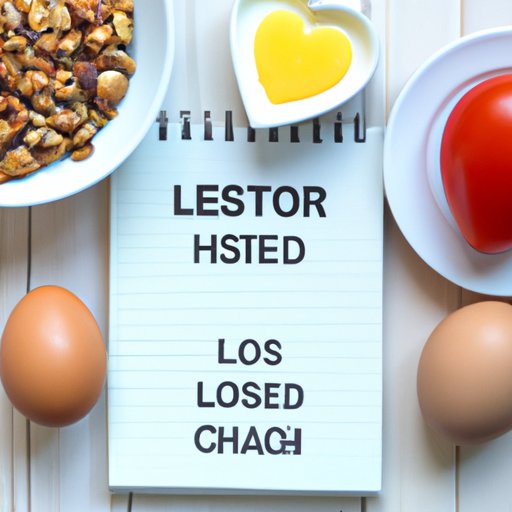Introduction
Cholesterol plays a vital role in keeping our bodies healthy, but too much of it can lead to various health complications, including heart disease. Thankfully, there are ways to manage cholesterol levels, one of which is following a low cholesterol diet. In this article, we discuss everything you need to know about low cholesterol diets, including what it is, its benefits, foods to avoid, and how to construct a meal plan. We also debunk the myth that low cholesterol diets are bland and offer tips for flavorful low cholesterol cooking.
The Truth About Cholesterol: How a Low Cholesterol Diet Can Improve Your Health
Cholesterol is a fat-like substance essential for various bodily functions, including hormone production and cell membrane formation. However, high levels of low-density lipoprotein (LDL) cholesterol – also known as “bad” cholesterol – can cause fatty deposits to accumulate in your arteries, leading to heart disease, stroke, and other health problems.
A low cholesterol diet may help lower your LDL cholesterol levels and improve overall heart health. Studies have shown that following a low cholesterol diet, combined with regular exercise and other lifestyle changes, can reduce the risk of heart disease and other ailments.
5 Foods to Avoid for a Low Cholesterol Diet
When following a low cholesterol diet, it’s crucial to avoid foods that contain high amounts of cholesterol. Here are some examples of foods to steer clear of:
- Red meat: Beef, pork, and lamb are high in saturated fats and cholesterol, making them a no-go for low cholesterol diets.
- Processed meats: Sausages, hot dogs, and bacon are high in sodium, saturated fats, and cholesterol, making them unhealthy choices for any diet.
- Egg yolks: While eggs are an excellent source of protein, the yolk is also high in cholesterol. Opt for egg whites or egg substitutes instead.
- Dairy products: Full-fat dairy products like cheese, milk, and yogurt contain high amounts of saturated fats and cholesterol.
- Fried foods: Fried foods, including chicken, fish, and tofu, are full of trans fats, increasing the LDL cholesterol levels in the body.
How to Construct a Low Cholesterol Meal Plan in 5 Steps
Meal planning can help you follow a low cholesterol diet and make healthier choices. Here are five steps to creating a low cholesterol meal plan:
- Choose lean sources of protein: Opt for lean protein sources such as chicken, fish, turkey, and plant-based options like beans and lentils instead of red meat and processed meats.
- Incorporate whole grains: Whole wheat bread, brown rice, quinoa, and oats are excellent sources of fiber and nutrients while being low in cholesterol and saturated fats.
- Select heart-healthy fats: Use plant-based oils like olive oil and canola oil instead of animal fats like butter and lard.
- Fill up on fruits and vegetables: Fruits and vegetables are low in cholesterol and high in vitamins and antioxidants, making them an excellent choice for any diet. Try to incorporate a variety of colors and textures on your plate.
- Limit added sugars and salt: Added sugars and sodium can increase your risk of heart disease, so try to reduce your intake by cutting back on sugary snacks, sodas, and processed foods and seasoning your meals with herbs and spices instead.
Low Cholesterol Cooking: Tips and Tricks for Flavorful Meals
Sometimes, the idea of eating healthy can be associated with bland and uninspired meals. However, there are ways to make your low cholesterol meals enjoyable by adding flavorful spices, herbs, and healthy fats, including:
- Using spices and herbs for added flavor: Try seasoning your meals with garlic, ginger, turmeric, paprika, and herbs like basil, thyme, and rosemary for extra taste and health benefits.
- Experimenting with different cooking methods: You can grill, roast, steam, or bake your favorite vegetables or proteins to add different textures and flavors to your meals.
- Adding flavor with healthy fats: Sprinkle seeds and nuts on top of your salads or roast vegetables in olive oil to add healthy fats to your meals while enhancing its flavor.
- Incorporating plant-based proteins for variety: Experiment with plant-based proteins like tofu, lentils, and beans to add variety to your meals. These protein sources are also low in saturated fats and cholesterol and high in fiber and nutrients.
The Benefits of a Low Cholesterol Diet: Why It’s Worth the Effort
Following a low cholesterol diet has several benefits for your overall health, including:
- Lower risk of heart disease: A low cholesterol diet can help reduce LDL cholesterol levels, decreasing the risk of heart disease and other cardiovascular diseases.
- Improved overall health: A diet low in cholesterol also means low in saturated fats, sugar, and sodium, contributing to better health and a lower risk of chronic diseases like diabetes, obesity, and stroke.
- Increased energy and vitality: Eating a healthy, low cholesterol diet can increase your energy levels and improve your overall mood and wellbeing.
Start incorporating small changes to your diet, like swapping red meat for lean protein or including more fruits and vegetables on your plate, to experience these benefits.
Conclusion
Following a low cholesterol diet may seem challenging, but it can significantly benefit your overall health and reduce the risk of serious health conditions like heart disease. By avoiding high cholesterol foods, constructing a low cholesterol meal plan, and experimenting with healthy and flavorful cooking methods, you can enjoy delicious meals while improving your health. Start making small changes today for lasting benefits.
(Note: Is this article not meeting your expectations? Do you have knowledge or insights to share? Unlock new opportunities and expand your reach by joining our authors team. Click Registration to join us and share your expertise with our readers.)
